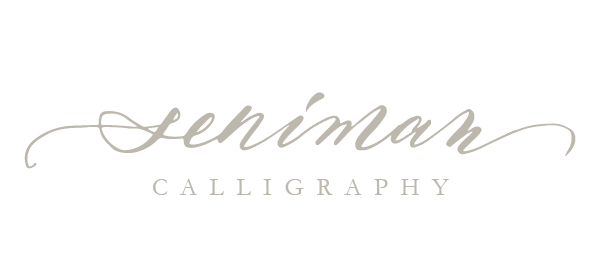Tutorial: How To Do The Perfect Envelope Addressing
And here's for a little tutorial on my favorite thing to do!
Yes, this is one of the favorite thing to do and my very first commission job I did was to do an addressing. Oh, nothing like walking down the memory lane! It's been a fun ride to say the least. To be honest, I love working on addressing! It's pretty therapeutic; just me, envelopes, nib, ink, and good music/podcast/audiobook. I like that I know what my schedule will be for a day or a week, depending on the quantity. And to top it off, I usually get pretty good amount likes and followers in Instagram whenever I share them!
I been asked a lot on Instagram regarding my addressing. And understandably so since calligraphy addressing is the main reason people pick up calligraphy! So, I did this how to post a while back for a popular Indonesian Calligraphy blog. Unfortunately, the actual post is in Indonesian and I haven't got a chance to do the English version until now! Well, better late than never so let's get started! Obviously, you need to be somewhat proficient in calligraphy. If you're unsure where to start, you can check out my workshops page for the next available class!
I'll be going over 2 different techniques I usually use to do addressing, one with lightpad for with envelopes without liners and another with a template. The second one can be use in all type of envelopes and the first one reduce my set up work by a lot. These two method are very low-tech and don't really require much investment (i.e. the laser slider) which make them perfect for beginners! "But, light pad is pretty high tech!", you might argue. Well, you can "fake" them by putting a light source (desk lamp) under a glass table! And if you do want to invest on a lightpad, it's worth every penny because they make illustration, painting, and sketching a breeze! And if you're curious, I use Wafer LED Dimmable Lightpad.
Doing Envelope Addressing with Light Pad
What you need: Lightpad, guidelines, and all your basic calligraphy near by!
1. Make your guidelines
I did mine from an extra white envelopes and I cut them slightly smaller than the envelopes. This should have evenly spaced lines for the name(s) and addresses (I trace mine from my Bienfang pad guidelines). I also add a center guidelines so it's easier to center everything. Sometimes I did additional guide for zipcode too.
What my guide looks like.
2. Insert the guidelines into your envelope like a liner.
Yup, nothing fancy but make sure the template is not moving around and perfectly straight. Another reason I like using same size envelope is to match the folded edge. It's an easy may to make sure it's straight.
What the guide looks like with the help of lightpad.
3. Start the addressing!
There's a few step to make life a bit easier. For centered addressing, I like to make sure my addressing print out accordingly (centered and spelled out "street", "avenue", and states). I'll penciled in my very first addressing to get a benchmark and adjust the rest of the addresses accordingly.
Oh and a little trick on zipcode, do the center (5) first. Then you do the first and fifth number (2) and last (3) in equal distance with the center number. This way, you can make sure the last two numbers will be evenly spaced!
Next is using a cutout template for guidelines!
What you need: Cut-out template from heavy cardstock, a lead pencil, all the calligraphy necessities, and eraser to erase your guidelines.
This one is necessary for doing addressing on colored envelopes or light envelopes with liners. It's much easier to do than measuring each and every line individually. It's the most low-tech technique so it's perfect for all the beginner (lightpad and laser slider cost a pretty penny for occasional use). So there's two kind of pencil you can use, a regular lead pencil for light color envelope or a white lead pencil for those dark envelopes. I use Fons and Porter White Lead Mechanical Pencil for the white and they're really easy to erase!
1. Create your guidelines as needed.
I have 2 cut-out template I use all the time, ones with all calligraphy addressing and another for name calligraphy with block lettering address. Make sure you have enough paper in between each cut out so they don't bend when tracing.
I like to do a notes on where the top and bottom is (I'm a bit clumsy) and notes where name(s) and address start. Additionally, I did another little guide to lower the guideline when my client said they want to use vintage stamps (they need a lot of space).
2. Trace the lines with center guide and notch for zipcode.
Here's what my traced envelope looks like!
3. Start the addressing just like the one above :)
Yes, that's pretty much it! Pretty simple right? Hopefully this tutorial will help you guys get going on your craft projects! And if there's any other tutorial you would like to know, I'd love to hear from you in the comment section or email me directly!
Much love,
Ruth
So let's end this tutorial with a seal. A wax seal to be precise ;) Check out my custom waxseal line in Stamptitude too!









